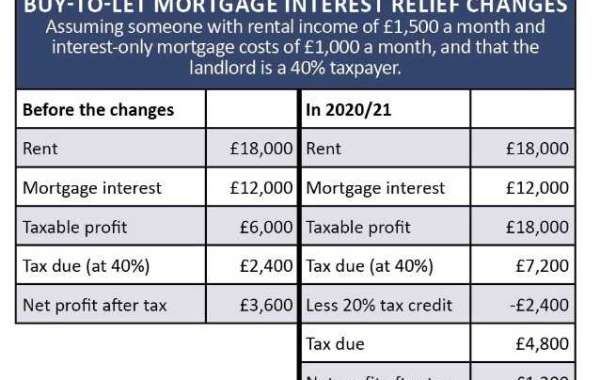If you are considering investing in a buy-to-let property in London, you must first consider how you plan to finance the investment. One option to consider is taking out a buy to rent mortgage. These mortgages are specifically designed for people who want to invest in property with the intention of renting it out. In this article, we will look at some tips for choosing the right buy-to-let mortgage to maximize your rental income.
1. Understand the Different Types of Mortgages Available
There are several types of mortgages available for buy-to-let investors. It's important to understand the differences between these mortgages to ensure you choose the right one for your needs. Some of the most common types of mortgages include:
a) Fixed-Rate Mortgages
A fixed-rate mortgage means that your interest rate is fixed for a specific period. This can be beneficial as it allows you to budget effectively and plan for your repayments.
b) Tracker Mortgages
A tracker mortgage means that your interest rate tracks the Bank of England base rate. This means that your interest rate can go up or down depending on the base rate.
c) Discount Mortgages
A discount mortgage means that you get a discount on the lender's standard variable rate for a specific period.
2. Look for the Best Deals
Once you have decided on the type of mortgage you want, it's important to shop around for the best deals. Look at the interest rates and the fees associated with the mortgage to ensure you are getting the best deal possible.
3. Consider the Rental Income
When choosing a buy-to-let mortgage, it's important to consider the potential rental income you will receive from the property. You want to ensure that the rental income will cover the mortgage repayments, so you are not left out of pocket.
4. Factor in Other Costs
In addition to the mortgage repayments, there are other costs associated with owning a rental property. These costs include maintenance and repairs, insurance, and property management fees. You need to factor these costs into your budget when choosing a buy-to-let mortgage.
5. Check the Lender's Requirements
Each lender will have different requirements when it comes to buy-to-let mortgages. Some lenders may require a higher deposit, while others may have stricter requirements for the property itself. It's important to check the lender's requirements before applying for a mortgage to ensure you meet their criteria.
6. Get Professional Advice
If you are new to the buy-to-let market, it's a good idea to seek professional advice. A mortgage broker or financial advisor can help you navigate the different types of mortgages available and help you find the best deal for your needs.
7. Keep an Eye on the Market
The property market can be volatile, so it's important to keep an eye on the market trends when choosing a buy-to-let mortgage. You want to ensure that you are getting the best deal possible, but you also want to ensure that the property market is stable.
8. Consider the Length of the Mortgage
When choosing a buy-to-let mortgage, you will also need to consider the length of the mortgage. Most mortgages are offered over a 25-year term, but some lenders may offer shorter or longer terms. You need to choose a term that suits your needs and budget.
9. Think About Your Future Plans
Finally, it's important to think about your future plans when choosing a buy-to-let mortgage. Are you planning on owning the property for the long-term, or are you planning on selling it in a few years? You want to ensure that the mortgage you choose
9. Think About Your Future Plans (Continued)
...aligns with your future plans and allows you to achieve your goals. For example, if you plan on selling the property in a few years, you may want to consider a shorter mortgage term or a mortgage with no early repayment charges.
10. Don't Overstretch Yourself
It's important to remember that owning a rental property can be risky, and there are no guarantees that you will make a profit. Therefore, it's important not to overstretch yourself financially when choosing a buy-to-let mortgage. You need to ensure that you can afford the mortgage repayments, even if the property remains vacant for a period.
11. Consider the Location of the Property
When choosing a buy-to-let property, the location is key. You want to choose a location that has a high demand for rental properties and offers a good rental yield. For example, areas with good transport links, good schools, and amenities are likely to be in high demand.
12. Check the Rental Yield
The rental yield is the income generated by the property as a percentage of its value. When choosing a buy-to-let mortgage, it's important to check the rental yield to ensure that the rental income covers the mortgage repayments and any other costs associated with the property.
13. Consider the Condition of the Property
The condition of the property is also important when choosing a buy-to-let mortgage. You want to choose a property that is in good condition and doesn't require extensive repairs or maintenance. This will help to minimize your costs and ensure that the property is attractive to potential tenants.
14. Understand the Risks
Owning a rental property comes with risks, such as void periods, rent arrears, and damage to the property. When choosing a buy-to-let mortgage, it's important to understand these risks and ensure that you have a contingency plan in place.
15. Seek Legal Advice
Finally, it's important to seek legal advice before entering into any buy-to-let mortgage agreement. A solicitor or conveyancer can help you understand the legal implications of owning a rental property and ensure that you are complying with all the necessary regulations.
In conclusion, choosing the right buy-to-let mortgage is key to maximizing your rental income. By understanding the different types of mortgages available, shopping around for the best deals, and considering the rental income and other costs associated with owning a rental property, you can make an informed decision that aligns with your goals. Don't forget to seek professional advice and keep an eye on the market trends to ensure that you are getting the best deal possible.
FAQs
- What is a buy-to-let mortgage?
A buy-to-let mortgage is a mortgage specifically designed for people who want to invest in property with the intention of renting it out.
- What are the different types of buy-to-let mortgages?
The different types of buy-to-let mortgages include fixed-rate mortgages, tracker mortgages, and discount mortgages.
- How do I choose the right buy-to-let mortgage?
You can choose the right buy-to-let mortgage by understanding the different types of mortgages available, shopping around for the best deals, and considering the rental income and other costs associated with owning a rental property.
- What are the risks of owning a rental property?
The risks of owning a rental property include void periods, rent arrears, and damage to the property.
- Do I need legal advice when choosing a buy-to-let mortgage?
Yes, it's important to seek legal advice before entering into any buy-to-let mortgage agreement. A solicitor or conveyancer can help you understand the legal implications of owning a rental property and ensure









